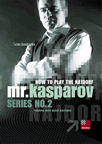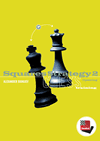 |
ChessBase Reviews |
Last updated 17 July 2005

| index |
CDs, DVDs, Software Part 22
Once again disks covered in this article come on either DVD or CD, so make sure you have the appropriate disk drive in your PC before purchasing them.

How to Play the Najdorf Vol. 1 By Garry Kasparov
The Sicilian Najdorf was a favourite of two of the world's greatest chess players of all time, namely Bobby Fischer and Garry Kasparov. I doubt if any of us could afford to pay either of them to visit our homes and give us a two to three hour lesson on an opening they spent a lifetime mastering. Yet this is basically what you get with this DVD. This DVD has the advantage that you can play it on both a PC and a standard TV DVD player. So for the non PC crowd you can simply watch the lectures on your TV in just the same way as you would watch a film. Of course I prefer to use the PC because you can get the full benefit of the instructional Fritz8-Chess Media System where, as well as watching the video lectures, you can follow the game moves on the playing board. You also have the advantage of being able to switch on your favourite analysis engine as you go through the lectures to see what it thinks is best as Garry explains each variation.
Garry’s delivery of the variation moves as he speaks them has been slowed down slightly from his previous DVD on the Queens Gambit, which makes it easier for slowcoaches like me to keep up with the variations. Some people say that the Najdorf has been analysed to death and as a result it is past its best. Well anyone watching this DVD is going to be hit full on in the face with his enthusiasm and I think rediscover a love for one of the great openings of the game. Be sure this will be only the first of a series of DVD’s by Garry on the Najdorf. It’s sure to be a fascinating journey. If you thought you knew the Najdorf prepare to learn a lot more.
The DVD includes the latest ChessBase 9.0 Reader, a large reference database with more than 16,000 Najdorf games, as well as a complete opening book that can be used to practice what you have learnt with Fritz. The various sections (given in minutes and seconds) covered are:
|
|
System requirements: PC (minimum 233 MHz and 32 MB RAM, recommended 1 GHz, 256 MB), DVD drive, Windows98 SE, ME, 2000 or XP, Sound card, Windows Media Player 9 or higher (for the multimedia lessons). Alternately: standard DVD player and TV set (PAL).

The Paulsen System B40-B49 By Norbert Sommerbauer
The second CD this time also covers another variation of the Sicilian and comes with the ChessBase reader for those of you who don’t own Fritz or one of its cousins.
As the title suggests, this CD covers the Paulsen System and the author covers lines like 1.e4 c5 2.Nf3 e6 and 1.e4 c5 2.Nf3 e6 3.d4 cxd4 4.Nxd4 Nc6 5.Nc3 Qc7 6.Be3 a6 7.Qd2 Nf6 and 1.e4 c5 2.Nf3 e6 3.d4 cxd4 4.Nxd4 Nc6 5.Nb5 d6 6.Bf4 e5 7.Be3 Nf6 8.Bg5 Be6 9.Bxf6 gxf6.
You should find ample material to provide you with a complete repertoire on the Paulsen. The CD starts with 34 excellent text chapters explaining all the various ideas. 330 games are analysed by Norbert and in total over 1000 games are annotated. The CD has 89,275 games on it which should be more than enough for a top class reference database for Correspondence players.
This is Norbert’s first title for ChessBase but with about 20 years experience in the opening he has made a good contribution.

Squares Strategy, Vol. 2 The Opening By Alexander Bangiev
This is the second CD on this subject from Alexander Bangiev who is a renowned chess coach. This CD is divided into 11 chapters with 162 annotated game fragments. The author is teaching you the basic logic of the game by giving you specific rules to work with. In essence there is no learning lengthy variations as you should learn to look at any position and find the best move. Games on the CD use the coloured arrows method of annotation rather than text which is a visual stimulus to the learning process which works rather well. The whole point is being able to see a position and be able to see where the best squares for your pieces are. Correspondence players tend to prefer having databases of thousands of games but it is well worth learning the methods on this CD.

ChessBase Opening Encyclopaedia 2005 By ChessBase
This is the first time ChessBase’s Opening Encyclopaedia has come out on DVD and it now has 2.2 million games with ECO codes. Over 72,000 of these are annotated. The opening key has been greatly enlarged on the previous CD. The DVD also has 3,600 opening surveys and 179 special theory databases. The big tree included lets you quickly browse through opening variations and see statistical results for the position reached.
This is a first class addition to your ChessBase program or playing programs. Mind you with its own reader you need neither. If you want a road map of opening variations this is definitely the way to go. Even if you don’t this is well worthwhile for the theory databases alone. All in all the best of both worlds.

The ABC of Chess Openings By Andrew Martin
I’ve said it before and I will I will say it again, Andrew Martin is one of the best at giving the type of instruction on this DVD. You get just over 5 hours of instructional video on this DVD and that has to be good value in anyone’s book.
Andrew Martin explores the diverse possibilities available to everyone in the opening phase of the game. The material is broken down logically into Open Games, Semi-Open Games, Closed and Semi-Closed Games, Flank and Irregular Openings. Invaluable advice is given about what to look for and how to play each specific category, and the instruction is enhanced by the use of recent, thematic master games to complement this advice. General instruction about how to play the opening is also included.
There is something here for everyone. Strong and even very strong players will enjoy the investigations into some excellent modern novelties, whereas the average player or even beginner will pick up a wide range of interesting ideas for use in their games. The author‘s love for the game comes through in this work, which he tries to communicate to the listener. If you want to learn the ideas behind the openings then buy this DVD.

Budapest Gambit By Dmitrij Oleinkov
The Budapest Gambit results after the moves 1.d4 Nf6 2.c4 e5. It is a popular surprise weapon of many top young grandmasters. If White holds on to the gambit pawn then Black gains a dangerous initiative. But also in the quieter lines there is a lot of scope for the imaginative attacking player. Dmitrij Oleinikov introduces you to the development of the Budapest Gambit and the current state of theory. In many database text articles and model games he explains the fundamental ideas of this opening. There are 60 training quizzes, sorted according to strategy, tactics and traps. They are ideally suited to test your knowledge after you have gone through the course. The CD contains teaching and training databases, but also a full reference database with over 13,000 games from the Budapest Gambit and a full position tree. All features at a glance:
- 13 database texts
- handy database prepared by the author containing 197 model games
- large database with approx. 13,000 games
- different training databases
- reader based on ChessBase 9.0
About the author: living in Moscow , Dmitrij Oleinikov is a journalist and has worked as a trainer for various Russian teams. He has also written the CD ROMs "Colle System" and "Bird Opening" published at ChessBase.
Just Out - Test Your Chess By Henrik Schlössner
In the training questions, the new function Multiple Choice also allows questions to be set about the evaluation of positions, or for example what chance is there of an attack on the king. Possible answers are always suggested and the training is done by clicking on what you consider to be the correct solution. But things do not have to be simple… The author has provided 555 game fragments with training questions and divided the material into six chapters.